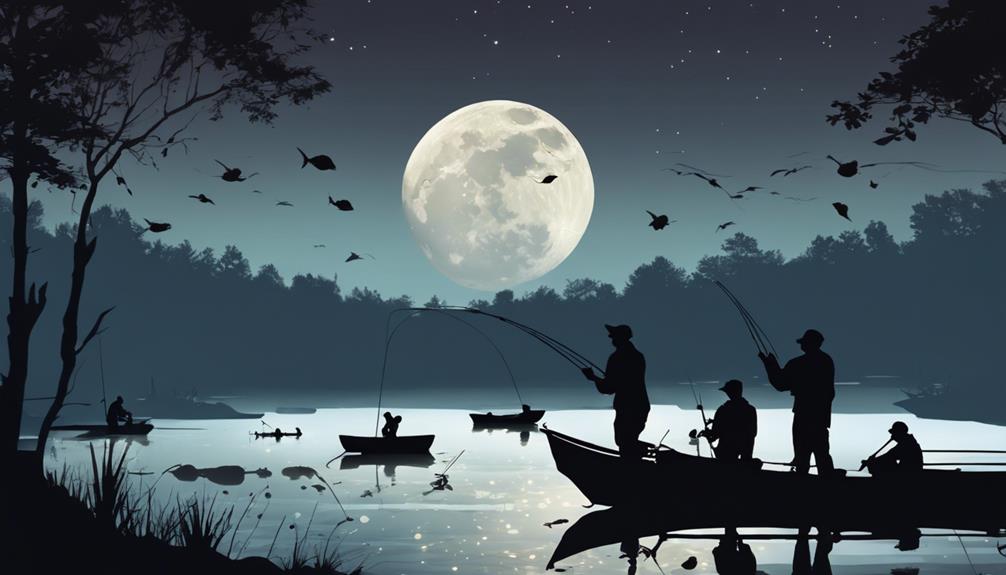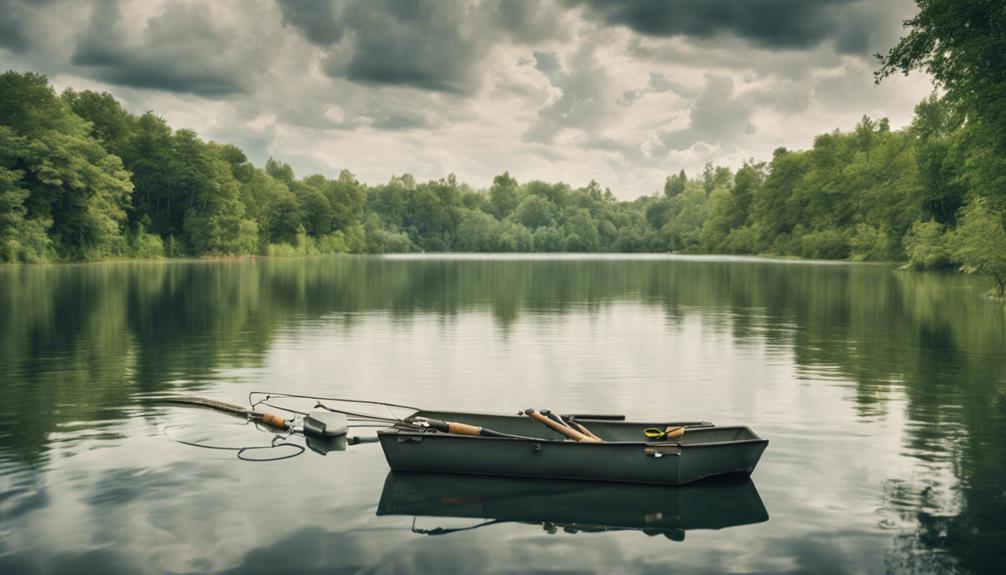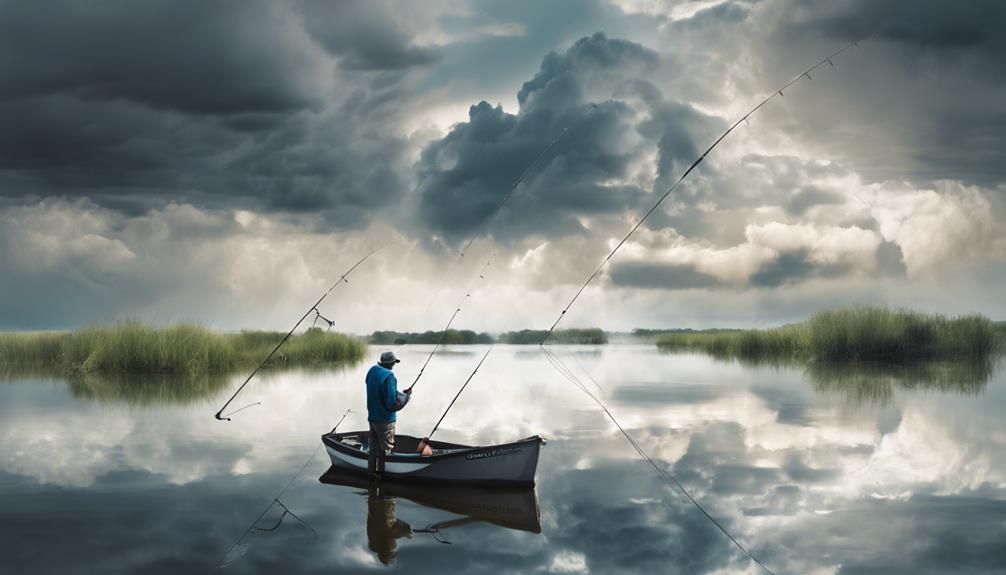Weather affects peak fishing times by influencing fish behavior, feeding habits, and environmental conditions crucial for successful fishing outings. For instance, sunny days enhance visibility, while rain triggers feeding frenzies due to barometric pressure changes. Wind direction can boost fish activity, and cloud cover makes them less cautious. Water temperature and lunar cycles also impact fish behavior. Understanding these factors helps tailor fishing techniques for optimal results. By grasping how weather interacts with fishing dynamics, you can maximize your chances of a successful fishing trip.
Sunny Days and Fishing Success
During sunny days, fishermen experience increased success due to optimal visibility and fish activity levels. The bright sun penetrates the water, allowing anglers to see fish more clearly and making it easier to spot their movements. This heightened visibility enhances the effectiveness of fishing strategies such as sight fishing, where anglers target specific fish they can see, leading to a higher catch rate.
Moreover, the increased sunlight on sunny days influences fish feeding habits. Fish are more active and tend to feed more during these conditions. The sunlight stimulates phytoplankton growth, which attracts baitfish, ultimately drawing larger game fish to feed. Anglers can capitalize on this by using lures that mimic the movement of these baitfish, increasing their chances of enticing bites.
Contrastingly, on overcast days, when the sky is cloudy and sunlight is limited, fish activity may decrease. The reduced light penetration makes it harder for fishermen to see fish, and fish themselves might be less active. During such conditions, anglers often adjust their fishing strategies by using baits that produce more vibration or noise to attract fish that rely more on their senses of touch or hearing rather than sight.
Rainy Weather and Fish Activity
When rainy weather sets in, fish activity levels can be influenced in various ways. Thunderstorm effects can have a significant impact on fish behavior. The drop in barometric pressure that often precedes a thunderstorm can trigger fish to increase their feeding activity. This is because the lower pressure makes fish more comfortable and less likely to experience swim bladder issues. Additionally, the increased cloud cover during a thunderstorm can make fish feel more secure, encouraging them to venture out and feed more actively.
On the other hand, cold front impacts associated with rainy weather can sometimes cause fish to become less active. Cold fronts bring cooler temperatures, which can slow down fish metabolism and reduce their overall activity levels. Fish may also seek out deeper waters or cover during a cold front, making them harder to catch. However, once the cold front passes and the weather stabilizes, fish activity often picks up again as they adjust to the new conditions.
Windy Conditions and Ideal Fishing
Windy conditions play a pivotal role in determining ideal fishing times due to their direct impact on fish behavior and feeding patterns. Wind direction is a crucial factor for anglers to consider when planning their fishing expedition. In general, fish tend to be more active and feed more aggressively when the wind is blowing towards the shore. This phenomenon occurs because the wind pushes the surface water, along with food sources, towards the shore, attracting fish to these areas. Anglers can take advantage of this by positioning themselves strategically to cast their lines in the direction of the wind, increasing their chances of a successful catch.
However, gusty conditions can also pose challenges for anglers. Strong winds can make casting more difficult, affecting the accuracy and distance of the cast. To overcome this obstacle, anglers can adjust their casting technique by using heavier lures or sinkers to help combat the wind resistance. Additionally, casting at a lower angle can also help minimize the impact of the wind on the line.
Cloud Cover Impact on Catch Rates
The presence of cloud cover significantly influences catch rates by altering fish behavior and foraging activity. Cloud cover and visibility play a crucial role in determining how successful your fishing trip will be. When the skies are overcast, the amount of light penetrating the water decreases. This reduction in light can lead to changes in fish behavior.
Under cloudy skies, fish tend to be less cautious and may venture into shallower waters or move closer to the surface to feed. The decreased visibility caused by cloud cover can make it easier for predators to ambush their prey, including the bait on your fishing line. This can result in more bites and increased catch rates during overcast conditions.
Additionally, overcast skies can also have a calming effect on the water, making it less choppy and turbulent. This can make it easier for fish to spot and approach your bait without being deterred by rough conditions. Therefore, when fishing under cloud cover, consider using topwater lures or fishing near the surface where the fish may be more active due to the subdued lighting.
Temperature's Role in Fishing Patterns
The temperature of the water plays a significant role in shaping the behavior and feeding patterns of fish, directly impacting the success of your fishing endeavors. Water clarity is closely tied to temperature, as warmer water tends to hold less oxygen and may affect the visibility levels underwater. Fish species have preferred temperature ranges in which they're most active and feed most actively. For example, cold-water species like trout are more active in cooler temperatures, while warm-water species like bass are more active in warmer waters.
When the water temperature increases, fish tend to be more energetic and require more food to sustain their activity levels. This can lead to increased feeding behavior, making it an optimal time for fishing. Additionally, understanding the temperature preferences of different fish species can help you select the right bait. Warmer water temperatures typically lead to an increase in metabolic rates, causing fish to be more responsive to live bait or lures that mimic fast-moving prey.
In contrast, when water temperatures drop, fish may become less active, requiring more finesse in bait presentation to entice them to strike. Adjusting your bait selection based on the water temperature can significantly improve your chances of a successful fishing trip. Remember, paying attention to water clarity and the relationship between temperature and fish behavior can make a substantial difference in your fishing outcomes.
Barometric Pressure and Fishing Behavior
Barometric pressure influences fish behavior by affecting their activity levels and feeding patterns in response to atmospheric pressure changes. As the barometric pressure rises or falls, it can have a significant impact on how fish behave in the water.
One key aspect influenced by barometric pressure is the movement of tidal currents. Changes in barometric pressure can cause shifts in tidal currents, influencing where fish congregate and how actively they feed. When the pressure is high, fish may move to deeper waters or seek sheltered areas to avoid strong currents. Conversely, when the pressure is low, fish may be more active near the surface or in shallower regions where food sources are more abundant due to the altered current patterns.
Moreover, barometric pressure changes can also affect oxygen levels in the water. High pressure tends to push the surface of the water down, increasing the pressure on the gases dissolved in the water, including oxygen. This can lead to higher oxygen levels in deeper waters, prompting fish to move to these areas for better access to oxygen. On the other hand, low pressure can result in decreased oxygen levels, driving fish to shallower waters where oxygen concentrations are higher.
Understanding these relationships between barometric pressure, tidal currents, and oxygen levels is crucial for predicting fish behavior and optimizing fishing success based on atmospheric conditions.
Moon Phases and Prime Fishing Hours

Changes in moon phases play a significant role in determining the prime fishing hours for anglers seeking to optimize their catch rates. The gravitational pull of the moon affects ocean tides, influencing the movement and behavior of fish. Understanding how lunar cycles impact fish feeding habits can greatly enhance fishing productivity.
During the new moon and full moon phases, when the gravitational pull is at its strongest, the tides are more extreme. This tidal influence can trigger fish to be more active, resulting in increased feeding behavior. As a result, many anglers consider these phases as optimal times to fish due to the higher likelihood of catching fish.
Conversely, during the quarter moon phases, when the gravitational pull is weaker, tides are less extreme. Fish may be less active during these times, leading to decreased feeding activity. Anglers may find that fishing during these phases is more challenging, with lower catch rates compared to the new and full moon phases.
Seasonal Changes and Fishing Opportunities
Seasonal fluctuations significantly impact the availability and behavior of fish, directly influencing the fishing opportunities for anglers. During the warmer months, water temperature plays a crucial role in fish activity. Warmer water temperatures increase the metabolic rates of fish, making them more active and likely to feed. This heightened activity leads to better fishing opportunities as fish are more readily enticed by bait.
Additionally, seasonal changes prompt fish migration. As seasons shift, fish move to different locations to find suitable water temperatures, spawning grounds, or food sources. Anglers can capitalize on these movements by understanding the typical migration patterns of the fish species they target. For example, in the spring, many fish species migrate towards shallow waters for spawning, presenting excellent fishing opportunities for anglers targeting these species.
Conversely, in colder months, water temperatures drop, causing fish to become less active. During this time, fish may move to deeper waters where temperatures are more stable. Anglers should adjust their techniques accordingly, using slower presentations and targeting deeper areas where fish are more likely to be found.
Frequently Asked Questions
Can Fishing Be Successful on Cloudy Days?
Yes, fishing can be successful on cloudy days. Rainy conditions can actually lead to increased fishing success as fish tend to be more active and less cautious during these times.
Overcast skies can also provide a sense of security for fish, making them more likely to venture out and feed.
How Does Barometric Pressure Affect Fish Behavior?
Barometric pressure impacts fish behavior by influencing their activity levels and feeding patterns. This environmental factor plays a crucial role in determining fishing success.
As pressure changes, fish may move to different depths or locations, affecting their willingness to feed. Understanding these dynamics can help you adjust your fishing strategies accordingly to maximize your chances of a successful catch.
Do Moon Phases Really Impact Prime Fishing Hours?
Moon phases play a crucial role in determining prime fishing hours. Fish activity is influenced by lunar cycles, affecting their feeding patterns and behavior.
Understanding how moon phases impact fish behavior can significantly increase your fishing success. By aligning your fishing trips with the appropriate moon phase, you can maximize your chances of catching more fish during peak feeding times.
It's essential to consider the moon's position when planning your fishing excursions.
Are There Ideal Fishing Conditions During Windy Weather?
During windy weather, fishing success can vary. Wind can affect fish behavior and water currents, making it challenging to predict ideal fishing conditions.
Cloudy days can sometimes be more favorable for fishing due to reduced light penetration and potential changes in fish activity levels.
Understanding how different weather conditions impact fish and adjusting your fishing techniques accordingly can help maximize your chances of a successful catch during windy weather.
How Do Seasonal Changes Affect Fishing Opportunities?
Seasonal patterns greatly impact fishing opportunities. As temperatures fluctuate, fish behavior changes.
For example, during warmer months, fish tend to be more active and close to the surface, making them easier to catch. Conversely, in colder seasons, fish may move to deeper waters or become less active.
Understanding these shifts and monitoring water temperature can help you adapt your fishing techniques for better success throughout the year.
Conclusion
In conclusion, weather plays a crucial role in influencing peak fishing times. From sunny days to rainy weather, windy conditions, and cloud cover, each element can impact fish activity and catch rates.
Factors such as temperature, barometric pressure, moon phases, and seasonal changes also play a significant role in determining the best times for fishing.
By understanding how weather affects fishing patterns, anglers can increase their chances of success and optimize their fishing experiences.



